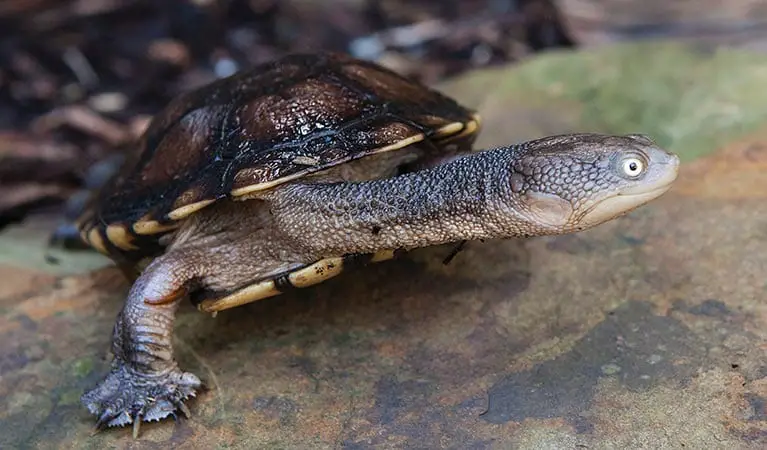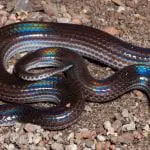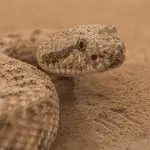Scientific facts
| Common Name | Snake-Necked Turtle |
| Scientific Name | Chelodina longicollis |
| Habitat | Different bodies of water such as rivers, swamps, and other moving waters |
| Diet | Fish, crustaceans, tadpoles, frogs, plankton mollusks, and terrestrial insects such as worms, ants, bees, etc. |
| Size | Female: 28.2 cm (11.1 in)Male: 24.9 cm (9.8 in) |
| Color | The carapace and other parts of the body that has shades of dark brown or black with undersides of color yellow or cream |
| Lifespan | 30 years |
Physical Descriptions
The snake-necked turtle is named after its long neck and some of its behavioral patterns like that of a snake. It has a carapace and other parts of the body that has shades of dark brown or black with undersides of color yellow or cream. Its neck, which appears to be at least more than half of its body, has the ability to move its neck in different directions, especially in hunting prey. Baby snake-neck turtle has an orange pattern on their undersides.
Where It is Seen?
It is an endemic species to Australia that has a population that had been distributed all over is an east Australian species of snake-necked turtle that inhabits a wide variety of water bodies and is an opportunistic feeder west of Adelaide,.northwards to the Fitzroy River of Queensland and all over South Wales and Victoria.
Habitat
Snake-neck turtles are semi-aquatic species that can stay long in the land and in the water. They are usually found in different bodies of water, such as rivers, swamps, and other moving waters. They also need to burrow in fallen leaves or in the ground filled with greens such as grass.
Behavior and Temperament
When the Snake-necked turtle is threatened, it will hide under its shell, and it emits a fluid from its musk glands that has an offensive smell, this ability of this turtle makes it popular in the name of a stinker. This fluid will pass through its groin and armpit when you handle it. The reason why it is called a “snake turtle” is because of the appearance of its neck that can be compared to a snake, and the way how it captivates its prey is like what snakes do.
Diet
Snake-necked turtles are totally carnivorous that eats different varieties of small moving creatures such as fish, crustaceans, tadpoles, frogs, plankton, and mollusks. As you notice, their food can be seen under the bodies of water, but sometimes they also eat terrestrial insects such as ants, bees, spiders, worms, etc.
Size and Weight
Females grow larger and heavier compared to males since they are the ones who will carry their offspring. The average size of females is about 28.2 cm (11.1 in), and the males reach the size of about 24.9 cm (9.8 in).
Life Span
These kinds of turtles have difficulty living in for years due to different factors, but usually, they have a lifespan of about 30 years. In captivity, since all factors are controllable, they can live up to more than 30 years.
Breeding and Reproduction
These types of turtle species are considered polygynandrous, wherein they tend to have multiple mating partners in a particular breeding season. They even go to one place to another to have higher chances of mating. The males start to court females by means of touching the cloacal of females and head bobbing when the male is successful in attracting the female; the copulation is done in the waters.
The nesting season happens during the late spring or early summer, where the females will be actively searching and digging in nest sites near the water. They may lay at least 10-25 eggs, where it has a total of the incubation period of 150 days, and it usually hatches during the rainy season or fall.
Common Illness/Diseases
Nutritional Diseases
The food you are serving them is where most of their nutrients come from. If your turtle always gets the optimum nutritional value it needed to grow; then it will have better immune responses against different kinds of illnesses or diseases. A turtle who is suffering from nutritional deficiencies can be seen on its sick physical appearance, and it causes them to be inactive. There are supplements that you can mix in their food to avoid any nutrients deficiency.
Infectious Diseases
This is common to aquatic turtles living in a poor environment caused by different kinds of bacteria. Some of the infections the turtle get are digestive tract, respiratory tract, ears, skin, and shell infections. For external infections ranges from mild to severe. The condition is mild if the infection is only within the superficial or keratin layer that may be cured through topicals, and it is considered severe when the infection is absorbed through the skin until the bones.
Parasite infections
When the turtle has diarrhea that has fecal with blood, there is a possibility that it suffers parasitic infection, specifically worms, and amoeba that affects the kidneys, liver, digestive tract, and the circulatory system. The turtle may need to undergo antibiotic treatment. It is important to ensure that the food that you will be giving to them is always clean.
Reproductive Diseases
During the reproductive cycle of females during sexual maturity, it undergoes different processes to form the eggs. The problem arises anywhere this process; a common reproductive problem is when the eggs remain too long in the oviduct and fail to ovulate that may be a cause of decomposition that leads to yolk coelomitis, which cause different complications that is fatal. When a fully grown egg can’t go out because of its size, it may move to different areas of the turtle’s body such as their urinary bladder or colon that causes obstruction and complications. These stuck eggs should be removed by means of surgery only.
For males, their penis becomes traumatized and somehow deformed during the mating process, and sometimes, they tend to copulate on things that have a shape or looks like a turtle such as rocks. If their penis remains extruded due to swelling, it needs medical attention. In some severe cases, the penis may be amputated.
Foreign Bodies
Snake-necked turtles are quite curious about everything that they see. They use to eat everything that they see, especially small items such as gravel, jewelry, coins, etc. If the turtles are large enough, it can just pass through in its digestive system without a problem; however, large items may be trapped in their digestive system that may cause an obstruction. If not removed, it may be fatal, which is why, at times, surgery is needed. In captivity, make sure that their housing is always clean, free from small accessories that they can put in their mouths.
Trauma
Even though the shell’s appearance is hard, the turtle can feel pain when somebody knocks on it or when the turtle bump on something. They can get trauma through accidents, and this is seen on their shells. You should be able to determine a mild to severe damage on the shell. There are techniques made so that the shell will be repaired.
Preventing Illness
Experts suggest that for these common diseases to be minimized, you may need to ensure that their husbandry needs to be the same as what they have in their natural habitat. If you just acquired your turtle somewhere, it is best to bring it to the veterinarian for a general check-up to ensure that it is not a carrier of any disease.
If taken in captivity already, make sure to observe them regularly, if there are signs that your pet is sick, take them immediately to the veterinarian unless you know how to give first aid. If you are housing two snake-necked turtles in one tank and if so happen that the other has wounds, isolate it immediately. Turtles may bite each other, especially during mating that is why wounds can’t be avoided. If possible, avoid housing two Snake-Necked Turtles in one housing.
Availability-Where to Get One
Since this species is not yet included in the list of threatened and endangered turtles, it can still be seen in different reptile shops. You can also avail one through reptile collectors. The supply of these turtles found in the pet shops or in different collectors came from the wild hunted by them or through cultivators who practice breeding among these species.
Captive Breeding
Turtles are common pets taken in captivity because they are cute and easy to tame creatures. They do not pose a danger to humans and that taking good care of them does not need a high maintenance lifestyle, you’ll just need to be sure that their environment in captivity is just like their natural habitat in the wild.
How to Care Reptile as a Pet
Housing
To ensure that Snake-necked Turtle will grow healthily in captivity, it is important to create an environment for them that mimics their natural habitat. Experts would say that these turtle species are quite challenging to care for in captivity because setting up their housing with a complete accessory is complicated. Their tank should have both terrestrial and water spaces and where direct sunlight or lighting equipment is present.
The tank should be large enough where the turtle can bask, hide, swim, and rest. To maintain the water hardness, you may add aquarium salt since this turtle thrives well in water hardness. You also need to check that the pH level of the water is from 7.0 to 8.2 alkalinity. You must clean the whole tank at least once every two weeks, but the water needs to be replaced twice a week. To avoid shocking your turtle’s body, change about 24% of water first.
Substrate and Accessories
In the land area of the tank, you may need to use a combination of sand and peat moss, while for the aquatic area, the bottom should be equipped with layers of gravel with deep water where the turtle can freely swim. To ensure that the aquatic area has clean water, install a water filtration system and also there are times when the water should be heated if the outside temperature is freezing to maintain the optimal temperature level for them to thrive which is at 72-80 degrees Fahrenheit that is why you may also need to set up a water heater. For the hiding place, you can make use of logs.
Lighting Equipment
Basking is an important activity for the turtle to get sufficient nutrients. Since it is impossible to give expose them to the sun, you may need to expose them to UV and blue-green light. The UV lights can enrich them with Vitamin D, and the blue-green light is for proper digestion of food. Make sure that the UV lights are situated near their basking area to maximize its effects.
Feeding
You can feed your turtles with frozen turtle food and other food diets such as crickets, roaches, fish, earthworms, and super worms. To avoid nutrient deficiency, add supplements in their food enriched with vitamins and minerals. You can give them live insects once in a while if you have one so that it will be interesting for them. Feed young Snake-necked Turtle every day for it to grow fast while adults can be fed every other day. Be mindful of the amount of food that you will give because turtles will eat all the foods that you will them making them prone to obesity.
Conservation Status
The major threats to their population are the destruction of their habitat, illegal hunting for pet trades, and their eggs are often eaten by rodents. For these issues to be addressed, there were captive breeding efforts that aim to increase their population. There are also protected areas where illegal hunters are not allowed to get anything.
Facts About Snake-necked Turtle
- Snake-necked Turtle is known as a pungent stinker because they spray a pungent smell that can range up to 3 feet when they are stressed and threatened. In captivity, always wear gloves so that your hands wouldn’t be sprayed by their stink when they are not comfortable.
- Males and females look the same until they mature at 6 months. It is not possible to breed them until they reach maturity, so the best time for them to breed is at 7 years old or nuking the males have a V-shaped indentation on their tails and a U shape for the females that will allow them to release eggs.
- They hunt their prey like a snake. They will hide under their shells as they approach their prey and catch them by surprise as snakes do.
FAQ Section
Do Snake-Necked Turtle feels loneliness?
These species are not social creatures; they do not need somebody else on their tank because they do not feel any loneliness.
Does Snake-Necked Turtle recognize their owners?
Yes! These turtles know their owners by means of sounds and visual appearance. You may perceive that they do not recognize you, but they actually acknowledge you as their owners.
Do turtles have feelings?
Like other animals, they have feelings as well. They can feel pain, especially pain inflicted on them physically.
Do turtles like being touched?
Turtles are commonly taken into captivity because they are desirable pets. However, they do not like being handled too often, that is why if you don’t have any idea about caring for them, they may die sooner.
Do Snake-necked Turtle bond with humans?
There are times when your turtle is in the mood to bond with you. They like their chins and heads to be stroked instead of their shells. Be sure to always wash your hands when you handle them because they may carry bacteria, which is the salmonella that can be transferred to humans.
How can you tell a Snake-Necked Turtle’s age?
For you to know the age of your turtle, you may count the rings on the scute.
What happens if you touch your turtle?
Reptiles such as Snake-Necked Turtle harbor Salmonella bacteria than can be transmitted to humans easily; that is why when you handle it, make sure to always wash your hands.
What kind of noise does your Snake-Necked Turtle make?
They do not have vocal cords; that is why it is impossible for them to make other noise other than bellowing, hissing, and grunting.
Can a Snake-Necked Turtle survive without its shell?
This turtle will not die automatically without his shell, but since this shell protects the turtle’s important organs such as its lungs and spinal column, there is a possibility that it cannot live long without it.
Do your pet Snake-Necked Turtle bite?
As a defensive mechanism, aside from hiding in their shells, they may bite when threatened, and it may cause mild to severe injury depending on the size of the turtle.
How Long Can Snake-Necked Turtle go without eating?
They can live for months without food, but a responsible pet owner wouldn’t leave their turtles for weeks without food and water.



